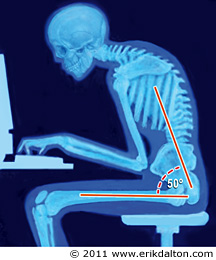 Posture is not the way you consciously carry yourself, it is the position that the muscles pull your skeleton into. Your muscles compensate for your daily duties and become short and contracted pulling the skeleton off of postural alignment or long and weak allowing the skeleton to drift off of postural alignment all in an attempt to level your head ,level your hips or correct for an injured muscle.
Posture is not the way you consciously carry yourself, it is the position that the muscles pull your skeleton into. Your muscles compensate for your daily duties and become short and contracted pulling the skeleton off of postural alignment or long and weak allowing the skeleton to drift off of postural alignment all in an attempt to level your head ,level your hips or correct for an injured muscle.
Working on computers, driving, or even sitting and watching television, over time will develop short or long muscles. When the head moves forward (crane forward) the shoulders round. This poor posture will gradually tighten the chest muscles and weaken the back muscles. This chronic change in posture can have a big impact on our general health, not only setting us up for tendinitis and compression of the nerves (the communication system of the body) but also effecting even the internal organs such as the lungs. Over time we will begin to have chronic pain, tight and tense shoulders, or even numbness and tingling down the arm. Simply retracting your head will not correct the problem. In fact, this can cause a jamming of the lower cervical vertebrae compressing more nerves and bulging discs.
Posture, Our Lifestyles & Health
Our high tech, fast-paced and demanding world relies on computers, cell phones and automobiles. Driving, sitting in front of computers, and stressful situations lead to chronic aches and pains. More and more of us suffer from neck and back pain, carpal tunnel, eye strain, TMJ, shoulder tension and migraine headaches. The human body is wired to cope with stresses through the release of hormones which increases heart and respiratory rates as well as muscle tension while decreasing digestion, which leads to weight gain. Sitting can lead to poor circulation which can lead to fluid retention and high blood pressure. Common tension patterns in the neck, shoulders and lower back can cause migraines and headaches. While many of these symptoms seem like simple discomforts or annoying distractions, if gone unchecked, these stress reactions can lead to debilitating health problems. What seems like small aches and pains can build over time and can be quite serious. Poor posture, respiration, circulation and digestion go hand in hand. Lack of mobility and compression of the spine can lead to poor nerve innervation and cause a host of disease like symptoms. Chronic pain interrupts normal life and prevents us from enjoying each day.
Correcting Posture
If you have good posture, your ear, shoulder, hip, knee and ankle should sit in vertical alignment. In other words, if you drop a plumb line from your ear it should pass through all those points. If you have a lot of forward head posture then the imaginary plumb line will fall in front of these points. The danger of forward head posture is the domino effect. The head moving forward, the head shifts the center of gravity. To compensate, the upper body drifts backwards. To compensate for the upper body shift, the hips tilt forward. When the head moves forward it tends to look down. To compensate, the muscles in the back of the neck tighten which pinches nerves down the arms and to the face and brain, and restricts the muscles of respiration and tightens chest muscles. Tight chest muscles pulls the arms forward which put a greater strain on the lower back, which cause the hips to tip. To compensate for the hips tipping, the knees bend which forces the muscles of the thighs to strain which puts stress and pain across the knee joints. The knees become unstable and the lower leg and feet change to carry an unnatural burden. The worse problem, forward head posture effects the brain. Forward head posture effects dopamine and serotonin levels which effects Parkinson’s and Alzheimer’s. The good news is that it is all preventable and correctable. We find the cause and correct the distressed muscle or muscle group.
